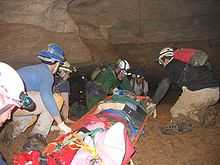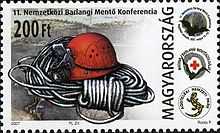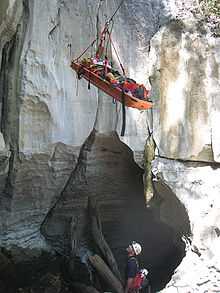Cave rescue

Cave rescue is a highly specialized field of wilderness rescue in which injured, trapped or lost cave explorers are medically treated and extracted from various cave environments.
Cave rescue borrows elements from firefighting, confined space rescue, rope rescue and mountaineering techniques but has also developed its own special techniques and skills for performing work in conditions that are almost always difficult and demanding. Since cave accidents, on an absolute scale, are a very limited form of incident, and cave rescue is a very specialized skill, normal emergency staff are rarely employed in the underground elements of the rescue. Instead, this is usually undertaken by other experienced cavers who undergo regular training through their organizations and are called up at need.
Cave rescues are slow, deliberate operations that require both a high level of organized teamwork and good communications. The extremes of the cave environment (air temperature, water, vertical depth) dictate every aspect of a cave rescue. Therefore the rescuers must adapt skills and techniques that are as dynamic as the environment they must operate in.
Overview

A network of international cave rescue units is organised under the banner of the Union Internationale de Spéléologie (UIS). Most international cave rescue units such as the New South Wales Cave Rescue Squad based in Sydney, Australia are listed with contacts in the event of a cave incident.
The world's first cave rescue team, the Cave Rescue Organisation (CRO), was founded in 1935 in Yorkshire, United Kingdom. Like all UK cave rescue groups it is composed of volunteer cavers and funded entirely by donations.[1] In the UK teams typically have 'callout lists' containing the details of up to 200 cavers who can be contacted in case of an emergency.
Organized Cave Rescue Units in the United States are generally city/county funded volunteer squads, composed mainly of seasoned, local cavers. The typical Southeastern US cave rescue team averages between 15 and 20 active members. Due to the excessive amount of manpower required on a large scale cave rescue, it is not uncommon for multiple cave rescue units from various regions to assist another in extensive underground operations. Because organized cave rescue teams are quite rare, it is also quite common for local units to cover regions that extend far beyond their agency's jurisdiction. The number of cave rescues in North America are relatively small compared to other common wilderness rescues. The average number of reported cave related incidents is usually 40 to 50 per year. In most years approximately 10 percent of reported accidents result in death.[2]
In the US, the leading cave rescue training curriculum is developed and deployed by the National Cave Rescue Commission[3] (NCRC), which operates as part of the National Speleological Society (NSS). The NCRC is not an operational cave rescue unit, but the organization is composed of members of regional rescue squads.[4] The NCRC offers training across the country in the form of two day "Orientation to Cave Rescue" classes as well as longer regional and National week-long training classes. The National Cave Rescue Operations and Management Seminar is a week-long class offering 4 different levels of training and is held in different locations around the country every year.
Historical examples
- Marcel Loubens from Pierre-Saint-Martin Cave in the French Pyrenees in 1952. Loubens died from a fatal plunge down the 1,135-foot (346 m) entrance shaft after a clasp on his harness broke on ascent. Members of Loubens' expedition spent over 24 hours attempting unsuccessfully to haul their friend back to the surface. Despite the efforts of the team doctor, Loubens died 36 hours into his ill-fated rescue attempt. After his passing the remaining members aborted their recovery attempt. Louben's body remained in the cave for two more years before cavers returned him to the surface in 1954. The blood transfusion given to Loubens by the team doctor was likely the first subterranean care of its kind.[5]
- James G. Mitchell from Schroeder's Pants Cave in Manheim, New York in 1965. Mitchell was a 23-year-old chemist whose death made national headlines in February 1965 when he died of hypothermia after becoming stranded on rope in a 75-foot (23 m) pit with a frigid waterfall. Initial efforts to recover Mitchell's body failed. A rescue team was flown from Washington DC on Air Force 2. A subsequent three day effort to retrieve Mitchell was aborted after repeated failures and a collapse. The cave was abandoned and blasted shut, essentially making the cave a tomb. Mitchell's death made headlines again forty-one years later when a group returned to the cave and successfully recovered his remains.[6]
- Emily Davis Mobley from Lechuguilla Cave in New Mexico in 1991. More than seventy people worked over four days to bring her to the surface after her leg was broken. This was the deepest and most remote cave rescue in American history.
- Floyd Collins from Sand Cave in Kentucky in 1925. Likely the first high profile cave rescue in history. Collins' desperate situation in the depths of Sand Cave made headlines across America. Over 10,000 spectators flocked to Sand Cave in the week following the news of Floyd's predicament. The National Guard was called in to control the carnival-like atmosphere surrounding the cave. Despite the heroic efforts of volunteers who attempted to dig a parallel shaft to free Collins, he was found dead, buried to his shoulders in debris. One 25-pound rock had jammed Collin's foot, preventing his escape. Collins remained trapped in Sand Cave for another 2 months until a crew of German engineers finished the digging of the shaft and extracted his body.[7]
- Neil Moss in Peak Cavern, England in 1959. Trapped in a narrow tunnel, he was eventually suffocated by carbon dioxide after prolonged efforts to free him. Rescuers were unable to free Moss and eventually the family asked that his body remain in the cave.
- Gerald Moni from McBrides Cave in Alabama in 1997. Moni and his group entered McBrides Cave in flood stage attempting a pull-down trip to the cave's lower entrance. A flash flood caused the situation in the cave to become extremely hazardous. While attempting to negotiate a pit being inundated with a high flow of water, Gerald mistakenly grabbed only one of two ropes necessary to descend the pit. The resultant fall to a ledge part way down the drop resulted in a broken femur. A few members of the group managed to negotiate the lower stream passage before it sumped and reached the surface. The others remained with Moni until local rescue agencies could mobilize and attempt a rescue. Rescue teams spent hours waiting for the water levels in the cave to recede enough to attempt an extraction. When teams finally reached Moni, he had been exposed to frigid water for over 12 hours. Rescue teams risked drowning themselves and Moni while traversing the flooded lower cave. 18 hours after his fall Gerald was returned to the surface alive.[8]
- John Edward Jones (1983–2009) in Nutty Putty Cave in Utah November 2009. John, an experienced caver, had become wedged in an unmapped portion of Ed's Push at a 170-degree downward angle with his feet over his head complicating rescue. After some 24+ hours they had been able to move him two feet upward, and lower down food and water, when a part of the rescue rope system failed dropping him fully back into the wedge. It was after this that he became much too weak to help the rescuers in their efforts and he expired shortly thereafter. As of now it's been decided by the family and landowner to leave his body in place and seal the cave permanently.[9]
In the United States
Organized Cave Rescue Teams generally utilize the Incident Command System (ICS). Originally devised for wildland fire teams, today the ICS is used by a variety of agencies throughout North America. The ICS can be modified by each agency depending on the nature of their emergencies. Below is an example of a typical cave rescue Incident Command System.[4]

- Incident commander
- is responsible for all activities, including the development and implementation of strategic decisions during the course of an incident. The IC monitors all aspects of an operation including planning, logistics, communications and information.
- Underground manager
- usually responsible for the implementation the plan provided by the incident commander. The underground manager assigns and monitors vital tasks including rigging, medical, patient packaging and transport, and communications with the IC on the surface. The underground manager is also usually responsible for the safety of the entire underground team.
- Initial response team
- a small unit of first responders. The task of the IRT is to travel through the cave to the patient and evaluate the situation with the purpose of reporting back to the appropriate manager. The IRT usually includes the medical personnel so medical intervention can begin early if necessary.
- Medical team
- varies in size and level of the medics ability from agency to agency. The medical team rarely participates in any other rescue function other than managing patient care.
- Communications team
- responsible for creating and maintaining communications between the teams in the cave and the Incident Commander. A common means of communications on a cave rescue are military field phones. Military phones are reliable but heavy, and the need for abundant amounts of com-line can make running communications deep into a cave difficult. Another, more advanced type of communication, are low frequency radios, which eliminate the need for thousands of feet of com line in a cave. Low frequency radios can communicate through thousands of feet of solid rock, making them ideal for use deep into caves.
- Rigging team
- responsible for one or more stations in a cave that require the rigging of ropes or systems to safely transport the patient and emergency personnel through the cave. In a large scale rescue, many rigging teams could be scattered throughout a cave, assigned with multiple tasks.
- Litter team
- made up of rescue personnel that are not already assigned to rigging, communications, medical or management positions. The responsibility of the Litter Team is the packaging and safe transport of the patient through the cave.
- Entrance control
- responsible for the logging of all personnel entering and leaving a cave. In some cases the Entrance Control could also be assigned the duty of logging all gear entering and leaving the cave. This is an important task on any cave rescue.
See also
References
- ↑ Eyre, Jim; Frankland, John (1988). Race Against Time: a History of the Cave Rescue Organisation. Lyon Equipment. ISBN 978-0950687445.
- ↑ American Caving Accidents
- ↑ National Cave Rescue Commission
- ↑ 4.0 4.1 Manual of U.S. Cave Rescue Techniques, 2nd Edition
- ↑ Jackson, Donald Dale (June 1985). Underground Worlds. Planet Earth 6. Time-Life. ISBN 978-0-8094-4320-8.
- ↑ "Spelunker's remains removed after 41 years". Associated Press. June 25, 2006. Retrieved 2011-09-26.
- ↑ Murray, Robert K.; Brucker, Roger W. (1982). Trapped! The Story of Floyd Collins. University Press of Kentucky. ISBN 978-0-8131-0153-8.
- ↑ Field Producer: Benjy von Cramon (December 2004). "Cave Flood". Expeditions to the Edge. Episode 8. National Geographic Channel.
- ↑ Hollenhorst, John; Dallof, Sarah (November 27, 2009). "Officials halt efforts to remove body from cave". KSL News. Retrieved 2011-09-26.
External links
| Wikimedia Commons has media related to Cave rescue. |